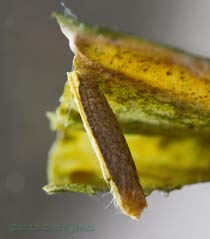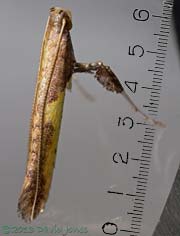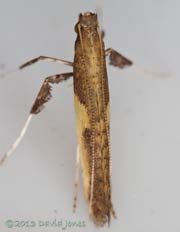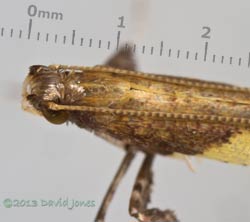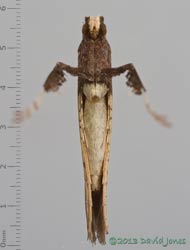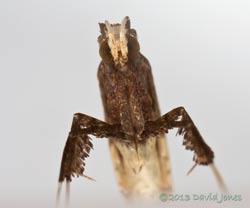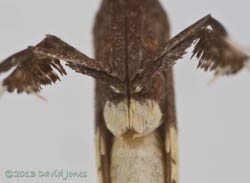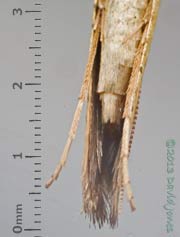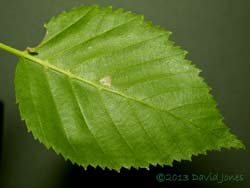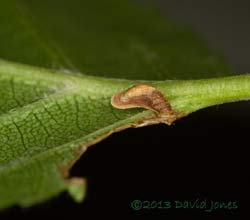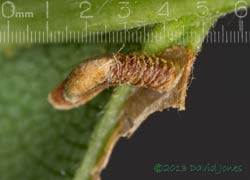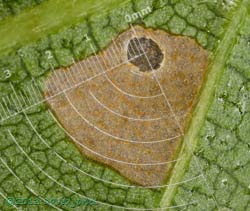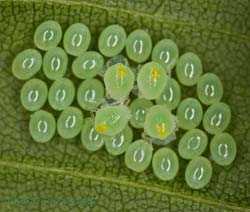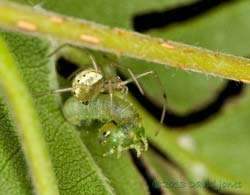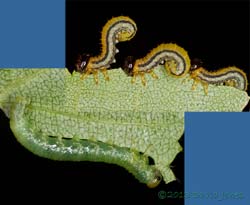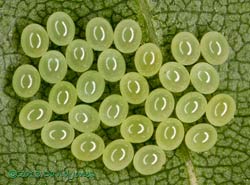Go to the last entry on this page .....Go to previous entry
27 June - A bright and mainly sunny morning before cloud moved in, followed by light rain by 5.30pm. A day when we got rid of our old fridge-freezer and replaced it with a more efficient model, so we will be living out of cooler boxes until sometime tomorrow! It has also been a day of taking things relatively easy, with time to investigate the mystery larva and come up with a probable identification. First, another picture that shows the leaf time back-lit brightly in an attempt to show up the overall shape of the inhabitant. It seems likely that it is a micromoth called Coleophora serratella, a species whose larva is very common on Birch trees, although it also feeds on other deciduous trees.
It seems that the young larva overwinters in a small case and then creates a larger case to complete its development in the Spring. You can find the first case attached to a leaf close to where it cut out the piece used to make its new case. I shall have to watch out for this next year... Pupation takes place in June - early July. Interestingly, the website UKmoths states that it pupates with 'the larval case fixed to the upper surface of a leaf in a sunny situation' which is quite different to the shaded underside of a branch chosen by 'my' individual. I can expect the adult to emerge in July.
When I got the container down to check on its contents there was a bonus in the form of another micromoth, measuring just 6mm in length that was attached to the outside of the glass. My search for an ID led me to a couple of possibilities, either Caloptilia semifacia, a species regarded a local and is found across the south of England, or Caloptilia falconipennella, a species described as rare in my guide although UKmoths states that 'Records suggest it has a fairly broad distribution, but is probably overlooked and may be more widespread than is currently known'.
Uncertainty about the ID is added to when you see what food plants the two species' larvae require - C semifacia feeds on Field Maple and occasionally Sycamore, while C. falconipennella feeds on Alder, Italian Alder or Grey Alder. While none of these species can be found in my garden, both Sycamore and Alder (hence our town of Aldershot!) grow locally. Also, to be sure of the ID I would need to dissect the moth - I'll just let it go!
Anyhow, here are some more pictures that may help someone to come up with a more confident stab at identification - First a dorsal view,
and then a close-up of the head and thorax.
Next, some views of its underside as it hung from a sheet of photographic glass. It hangs head down with its body subtending an angle of around 40° to the glass, and adopts a similar angle when on a vertical surface.
This time a close up of the head and thorax from below, showing the upturned (and light coloured) palps on the head, and the backwards pointing feathery bristles on the tibia of each midleg along with the tibial spur.
In this next image you can see some detail of the area. I'm not sure but the two light coloured bulbous structures are probably the tops (coxae) of the hind legs.
Finally, to the rear of the moth where you can see how both the hind legs and wings extend some way beyond the end of the abdomen itself. Tomorrow, as well as adding the large images I may get around to adding a scale to this and a couple of the other images.
29 June - After it was grey and sometimes damp yesterday, today was a warm and very pleasant summer's day, which was just perfect for our little grandson's second birthday - a good excuse for a family barbeque. However, before heading off to the party I did have time this morning to do a bit of very successful detective work down at the Birch tree.
This leaf was found some 2.5m above the ground, on the same side of the tree as the larva that found originally. In the middle of the leaf (underside shown here) there is a small feeding area, but more importantly, to one side of the leaf stalk you can see a small area of leaf missing, and something dangling below the leaf.
Taking a closer look showed that this has structure and was indeed a case made by the first larval stage of C. serratella rather than simply leaf debris.
Then it feeds again, adding more collars until in May when it leaves this tube , cuts out a section of leaf and creates a new case in which it will complete its development. This case is about 4mm in length,
which is in keeping with the dimensions of the area eaten on that same leaf, likely by the same larva after it had produced its new case. The larva does not completely leave the case during feeding, and the graphics on this image show that the maximum distance reached from the centre of the 'entrance' is just over 3mm, that opening measuring about 0.75 x 0.9mm.
Once the adult moth emerges from the pupa that I'm monitoring the next challenge will be to spot the first stage larva in action during the Autumn, assuming that a pair of adults mate and lay eggs on our Birch. More information (and further links) about C. serratella can be found at ukflymines.co.uk . However, I've yet to find a reference to where the larva hibernates. The timing suggests that it has to be on the bark of the tree, near to the leaves that the young larva had been feeding on. I will need to spot these leaves before they are shed by the tree.
Talking of eggs, I spotted this cluster on the 17th under another Birch leaf near 3m up in the tree, and today they began to hatch out. They look like bug nymphs, but I have no idea as to what type.
Finally, there are sawfly larvae in action on several Birch leaves, creating the winding channels in the leaves as they feed. However, they do not have things all their own way, and this individual has itself become a meal for a spider.
30 June - the last day of June turns into the hottest day of the year so far. At Farnborough they recorded 24C, although at Heathrow Airport the temperature reached 27C. Despite the glorious sunshine I spent very little time in the garden, apart from pruning the Burberis bush, but I did record a couple of things seen in the Birch tree. First, the larvae of two species of sawfly. The green one is similar to the larva being devoured by the spider yesterday. That one is now not much more than a shriveled up bag of skin. The more colourful trio are, I believe, part of the group that I photographed back on the 18th when they were very small. These are about 9mm long but it's difficult to measure them because of the way they curl up when disturbed.
Second, another cluster of eggs that seem identical to those I photographed yesterday, apart from these not hatching yet. This consists of 29 eggs, one less than the previous cluster.
Click on images to see larger versions
|
|
